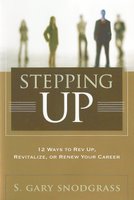‘12-step program’ pragmatic way to assess your career

Reviewed: “Stepping Up: 12 Ways to Rev Up, Revitalize, or Renew Your Career,” by S. Gary Snodgrass, Greenleaf Book Group Press, 2007, 87 pages, $13.95
When I have a big decision to make, I consult my personal short list of advisers: My mom, my sister and my best friend. The list widens the bigger the decision is, but those are my “Top 3.”
In career matters, however, sometimes what you really need is more objective advice. That’s where sources like “Stepping Up: 12 Ways to Rev Up, Revitalize, or Renew Your Career,” by S. Gary Snodgrass, come in.
This 87-page book, written by a human resources professional with 35 years of experience, offers a pragmatic approach to career moves.
Snodgrass’ resume includes 10 years as chief human resources officer for Chicago-based Exelon Corp., parent company of Exelon Nuclear, operator of the Limerick Generating Station in our own backyard. At Exelon, one of the nation’s largest energy companies with a work force of roughly 17,000, he led the corporation’s human resources, diversity, labor and employee relations and security functions. He is also the author of a previous book, “When Your Career Means Business.”
By its title alone, “Stepping Up: 12 Ways to Rev Up, Revitalize, or Renew Your Career,“ seemed like it might be an interesting and quick little read. And who doesn’t want to “rev up” their career?
I was a little taken aback, however, when I visited the author’s Web site (www.sgarysnodgrass.com), to find that he titles himself “Thought Leader and Consultant.”
Thought leader? I’m going to let that one pass.
The suggestions offered by Snodgrass could apply to those in their first “real job” as well as seasoned professionals.
“If you are searching for a new position or career, you should pursue an environment where the best employees are recognized and valued. It should be an organization that provides career growth, lifelong learning, and development opportunities. You also want meaningful work, an opportunity to contribute, and an environment that prizes new ideas and fresh perspectives,” Snodgrass writes.
He claims these types of organizations “abound.” (Well, perhaps they’re out there, anyhow.)
Snodgrass proposes taking control of your career path rather than simply going with the flow and letting it happen.
For example, in Guideline 5 — Evaluate Your Career Turning Points, Snodgrass states while a turning point can be something dramatic, such as marriage or a promotion, sometimes it will be “less obvious.”
“You may be disenchanted, or know in your gut that you’re not having fun any longer in your current position, place of employment, or even career field,” he writes.
Those are instances we should view “as a valuable opportunity for recharting the course” of our professional and personal lives, Snodgrass says.
And turning points, according to Snodgrass, are events we should embrace.
“If a turning point doesn’t come along, schedule one, and then reevaluate to determine your next step. For example, choose a memorable date such as your birthday or the anniversary of your employment to evaluate your work situation,” he writes.
In one of the book’s illustrative case studies, Snodgrass spotlights how John Mackey, founder and CEO of Whole Foods, knew he would have to compromise his once small vegetarian business and sell animal products in order to grow. Mackey decided to introduce humane animal-treatment standards and also placed a cap on executive compensation. His willingness to change his mindset ultimately helped to make “organic” a household word.
Each chapter has a similar nugget of wisdom for you to apply to your own work situation, with the goal of allowing you to “evolve to your highest level” at work as well as finding the organization that’s going to help take you there.
When I have a big decision to make, I consult my personal short list of advisers: My mom, my sister and my best friend. The list widens the bigger the decision is, but those are my “Top 3.”
In career matters, however, sometimes what you really need is more objective advice. That’s where sources like “Stepping Up: 12 Ways to Rev Up, Revitalize, or Renew Your Career,” by S. Gary Snodgrass, come in.
This 87-page book, written by a human resources professional with 35 years of experience, offers a pragmatic approach to career moves.
Snodgrass’ resume includes 10 years as chief human resources officer for Chicago-based Exelon Corp., parent company of Exelon Nuclear, operator of the Limerick Generating Station in our own backyard. At Exelon, one of the nation’s largest energy companies with a work force of roughly 17,000, he led the corporation’s human resources, diversity, labor and employee relations and security functions. He is also the author of a previous book, “When Your Career Means Business.”
By its title alone, “Stepping Up: 12 Ways to Rev Up, Revitalize, or Renew Your Career,“ seemed like it might be an interesting and quick little read. And who doesn’t want to “rev up” their career?
I was a little taken aback, however, when I visited the author’s Web site (www.sgarysnodgrass.com), to find that he titles himself “Thought Leader and Consultant.”
Thought leader? I’m going to let that one pass.
The suggestions offered by Snodgrass could apply to those in their first “real job” as well as seasoned professionals.
“If you are searching for a new position or career, you should pursue an environment where the best employees are recognized and valued. It should be an organization that provides career growth, lifelong learning, and development opportunities. You also want meaningful work, an opportunity to contribute, and an environment that prizes new ideas and fresh perspectives,” Snodgrass writes.
He claims these types of organizations “abound.” (Well, perhaps they’re out there, anyhow.)
Snodgrass proposes taking control of your career path rather than simply going with the flow and letting it happen.
For example, in Guideline 5 — Evaluate Your Career Turning Points, Snodgrass states while a turning point can be something dramatic, such as marriage or a promotion, sometimes it will be “less obvious.”
“You may be disenchanted, or know in your gut that you’re not having fun any longer in your current position, place of employment, or even career field,” he writes.
Those are instances we should view “as a valuable opportunity for recharting the course” of our professional and personal lives, Snodgrass says.
And turning points, according to Snodgrass, are events we should embrace.
“If a turning point doesn’t come along, schedule one, and then reevaluate to determine your next step. For example, choose a memorable date such as your birthday or the anniversary of your employment to evaluate your work situation,” he writes.
In one of the book’s illustrative case studies, Snodgrass spotlights how John Mackey, founder and CEO of Whole Foods, knew he would have to compromise his once small vegetarian business and sell animal products in order to grow. Mackey decided to introduce humane animal-treatment standards and also placed a cap on executive compensation. His willingness to change his mindset ultimately helped to make “organic” a household word.
Each chapter has a similar nugget of wisdom for you to apply to your own work situation, with the goal of allowing you to “evolve to your highest level” at work as well as finding the organization that’s going to help take you there.
Labels: book reviews, business, Michelle Karas, S. Gary Snodgrass, Stepping Up, The Mercury
 RSS
RSS


